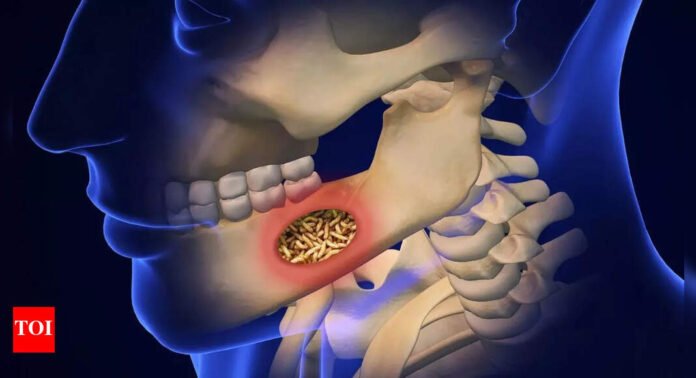Understanding Mouth Larvae: Causes, Symptoms, and Treatment

Mouth larvae, or oral myiasis, is a rare but serious condition. It causes discomfort and health problems. This issue often affects people with poor oral hygiene or weak health. Larvae feed on dead tissue in the mouth. If not treated, it can lead to severe pain, swelling, and tissue damage.
A larva is a young insect that hatches from an egg. Mouth larvae usually come from certain types of flies. These flies lay eggs in soft tissues inside the mouth, like gums and open wounds. These pests usually infect animals but can also affect humans in rare cases.
All About Oral Myiasis
Causes of Mouth Larvae
Mouth larvae, also known as ‘maggots,’ are small, worm-like parasites. They invade the mouth and cause a dangerous infection called oral myiasis. People can get this infection through open wounds, poor oral hygiene, or by eating food with larvae. Mouth larvae mainly feed on dead tissue, blood, and decaying matter in the mouth.
People living in tropical and subtropical regions are more likely to get this infection. This is especially true in areas with poor sanitation. Flies are attracted to open wounds or decaying tissues in the mouth. They lay their eggs, which then hatch into larvae.
Specific causes include:
- Alcoholism
- Dental extraction
- Mental illness
- Mouth breathing while sleeping
- Psychiatric disorders
- Substance abuse
Symptoms to Watch For
Symptoms of mouth larvae include:
- Bad breath from decaying tissue
- Swelling around or in the mouth
- Severe pain due to tissue damage and swelling
- Occasional bleeding from the affected areas
- Ulcers and sores in the mouth
- Sensation of movement due to larval activity
- Decayed or dead gums due to tissue decay
Early Signs of Mouth Larvae
Look out for these early signs:
- Consistent itching, discomfort, or irritation in the mouth
- Tiny red or white sores and swelling on the tongue, gums, or inner cheeks
- Unusual sensations, like crawling or tickling in the mouth
- Difficulty eating or swallowing
- Foul taste or bad odor from bacterial activity caused by larvae
Types of Mouth Larvae
Screwworm Fly Larvae
The female screwworm fly lays eggs on mucous membranes or wounds. The larvae burrow into the tissue after hatching. This pest commonly affects livestock and pets. It can cause death if wounds are left untreated.
Botfly Larvae
Botfly larvae can infect human tissues, including the mouth. They cause painful swellings, irritation, and ulcers. These larvae require surgical removal and can result in long-lasting discomfort.
Tumbu Fly Larvae
These larvae can enter the human body through open wounds. They can infest the oral cavity. People often get them through contact with infected animals or contaminated environments.
Treatment Options
Here are some ways to cure mouth larvae:
- Surgical removal of larvae
- Antibiotics to treat bacterial infections
- Consulting a dental expert to ensure no larvae remain
- Severe cases might need surgical procedures
- Local application of substances that can cause larvae to surface



